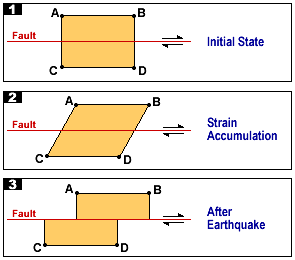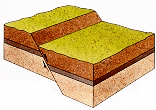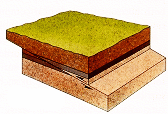
Introduction Normal faults Reverse Faults Thrust faults Strike-slip faults Related links

 |
Introduction Normal faults Reverse Faults Thrust faults Strike-slip faults Related links |
 |
|
Faults are great craks or fractures on the Earth crust. They exist due to the pressure that is applied on rocks in some parts of the crust, such as in the plate borders. |
Rocks can be made to break and fail in a varity of ways when they are subject to pressure. In one extreme, fractures form that divide the rock in sections. The sides of the fractures, called failure surfaces, slip abruptly past each other as the rock breaks into pieces. Stored energy is then suddenly released. In other failures, pieces of rock do not suddenly slip but grind slowly past eadh other. Such rock failures cannot release stored elastic energy. Geological faults are failure surfaces of large extent. As smaller rocks, the sides of a fault may slip gradually past each other or they may rupture suddenly releasing elastic energy. In such cases, we have an earthquake, and the two sides of a fault slip in opposite directions so that rocks once aligned are now displaced. Many faults in nature are enormously long; some can be traced for thousands of kilometers on the land surface. One of the most famous ones is the San Andreas fault in California; the seaward part slips northward and into the Pacific Ocean. |

Abrupt break of rocks or faults. Diagram a: Right-lateral shear strain (deformation) on a fault.Diagram b: Gradual movent of A-B relative to C-D.Diagram c: Rapid slip during earthquake relieves the strain and offsets the sides of the fault. |
|
Faults can exhibit a large variety in properties but still are classified in simple geological terms according to their geometry and direction of relative slip: |
Normal faultsA normal fault occurs when the ground is being stretched apart. Then, when the fault breaks, it allows land to slip downwards. |
 |
Reverse faultsA reverse fault is the result of the ground being squeezed together, with the result of one side of the fault riding up over the other as it breaks. |  |
Thrust faultsWhen the angle between the fracture surface (dip) and the horitzontal is small, reverse faults are called thrust faults. |
 |
Strike-slip faultsTo end with, we find a strike-slip faults where rocks are being sheared or forced to slip sideways past each other. |
 |
|
Normally real faults are a combination of all the faults described above. Once a fault has been formed, its sides can remain jammed together for decades or even centuries without moving. However, the area of the fracture is weak, and if forces place too much stress on it, the fault finally breaks again and the blocks of rock are further displaced. Every time that a fault breaks, the shock produces waves that, in their turn, cause the earth to shake: An earthquake is generated. |